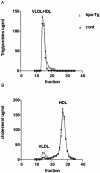Role of heparanase on hepatic uptake of intestinal derived lipoprotein and fatty streak formation in mice
- PMID: 21483695
- PMCID: PMC3070732
- DOI: 10.1371/journal.pone.0018370
Role of heparanase on hepatic uptake of intestinal derived lipoprotein and fatty streak formation in mice
Abstract
Background: Heparanase modulates the level of heparan sulfate proteoglycans (HSPGs) which have an important role in multiple cellular processes. Recent studies indicate that HSPGs have an important function in hepatic lipoprotein handling and processes involving removal of lipoprotein particles.
Principal findings: To determine the effects of decreased HSPGs chain length on lipoprotein metabolism and atherosclerosis, transgenic mice over-expressing the human heparanase gene were studied. Hepatic lipid uptake in hpa-Tg mice were evaluated by giving transgenic mice oral fat loads and labeled retinol. Sections of aorta from mice over-expressing heparanase (hpa-Tg) and controls (C57/BL6) fed an atherogenic diet were examined for evidence of atherosclerosis. Heparanase over-expression results in reduced hepatic clearance of postprandial lipoproteins and higher levels of fasting and postprandial serum triglycerides. Heparanase over-expression also induces formation of fatty streaks in the aorta. The mean lesion cross-sectional area in heparanase over-expressing mice was almost 6 times higher when compared to control mice (23,984 µm(2)±5,922 vs. 4,189 µm(2)±1,130, p<0.001).
Conclusions: Over-expression of heparanase demonstrates the importance of HSPGs for the uptake of intestinal derived lipoproteins and its role in the formation of fatty streaks.
Conflict of interest statement
Figures





References
-
- Vlodavsky I, Korner G, Ishai-Michaeli R, Bashkin P, Bar-Shavit R, et al. Extracellular matrix-resident growth factors and enzymes: possible involvement in tumor metastasis and angiogenesis. Cancer Metastasis Rev. 1990;9:203–226. - PubMed
-
- Williams KJ, Fuki IV. Cell-surface heparan sulfate proteoglycans: dynamic molecules mediating ligand catabolism. Curr Opin Lipidol. 1997;8:253–262. - PubMed
MeSH terms
Substances
LinkOut - more resources
Full Text Sources
Other Literature Sources
Molecular Biology Databases
Miscellaneous

